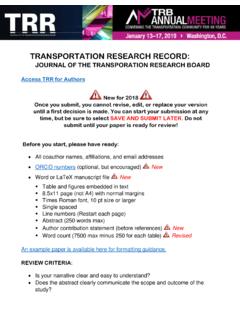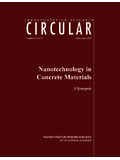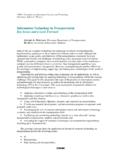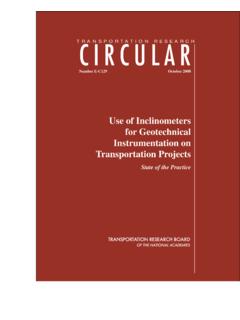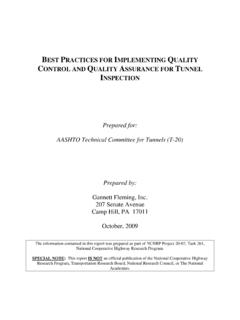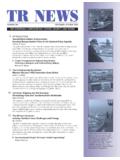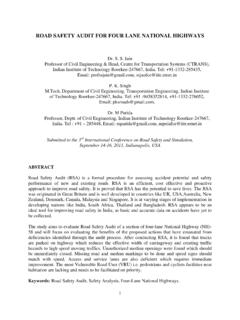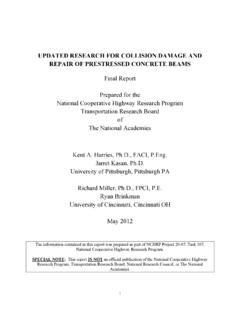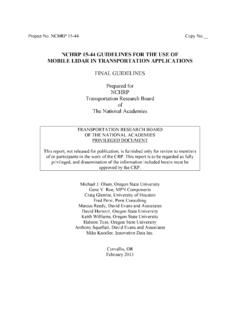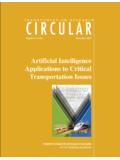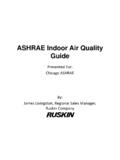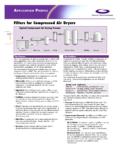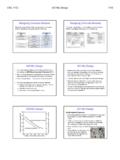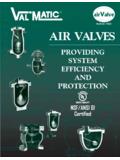Transcription of CARBON FIBER REINFORCED CONCRETE
1 SHRP 7f-4 4 45 .c I. '8992 c. r SHRP-ID/UFR-92-605 CARBON FIBER REINFORCED CONCRETE Strategic Highway Research Program National Research Council - Strategic Highway Research Program Executive Committee John R Tabb, Chairman M-pi Highway DrpMmnu William G. Agnew General Mown Resemh (rcrired) E Dean Carlson, Ex Officio Federal Highway Adminisum'on k Ray Chamberlain Colomdo Drpanmenl of Highways Raymond F. Decker Univmiry Science Pomvrs Inc. Thomas B. Deen, Ex Ofticio Tranqwnatbn Resemh Board Thomas M. Downs New Jersey Department of Transponation Tom Espy, Jr. Alabama Highway Department Francis B. Francois, Ex Officio American Association of State Highway and lkansponation OficiarS Donald N. Geoffmy New York Lkpanment of Trampnation William L Gila RUM Transponation Management Systems Boris Hryhorczuk, Ex Officio Manitoba Depanment of Transponation Thomas D. Larson, Ex Officio Federal Highway Administration Donald W. Lucas Indiana Depanment of Transponation Harold L. Michael Purdue University Wayne Muri MicSouri Highway and Tranrponation Department M.
2 Lee Pcnvcll, III Ballenger Paving Company, Inc. Henry A. Thomason, Jr. Taus Department of Highways and Public Transponation Roger L Yarbrough Apcon Corporation Key SHRP Staff Damian J. Kulash SHRP kcuiive Director Edward T. Harrigan SHRP Asphalr Program Manager Neil F. Hawks SHRP LTPP Prograni Manager Don M. Harriott SHRP CONCRETE & Suuctures/Highwq Operations Rvgram Manager Harry Jones SHRP Finance & Administration Director Karen Haas Smith SHRP Organizational Relations Director K Thirumalai SHRP-IDEA Program Manager SHRP-ID/UFR-92-605 CARBON FIBER REINFORCED CONCRETE Dr. Deborah Chung Department of Mechanical and Aerospace Engineering State University of New York at Buffalo Strategic Highway Research Program National Research Council I Washington, DC 1992 SHRP-ID/uFR-92-605 Contract ID412 Program Manager: Don M. Ham-ott Project Manager: Inum Jawed Production Editor: Marsha Bmtt Program Area Secretary: Ann Saccomano Apd 1992 key words: CARBON fibers compressive strength CONCRETE electrical resistivity flexural toughness flexural strength silica fume Strategic Highway Research Program 2101 Constitution Avenue Washington,DC 20418 (202) 334-3774 The publication of this report does not necessarily indicate approval or endorsement by the National Academy of Sciences, the United States Government, or the American Association of State Highway and Transportation Officials or its member states of the findings, opinions, conclusions, or recommendations either inferred or spedfically expressed herein.
3 Acknowledgments The research described herein was supported by the Strategic Highway Research Program (SHRP). SHRP is a unit of the National Research Council that was authorized by section 128 of the Surface Transportation and Uniform Relocation Assistance Act of 1987.. 111 Contents Acknowledgments .. iii List of Figures .. vii ListofTables .. ix Abstract .. xlii .. Executive Summary .. xv Introduction .. 1 Experimental .. 2 Price .. 14 Competition .. 15 Conclusion .. 15 Future Work .. 17 References .. 17 AppendixA .. 19 AppendixB .. 39 V List of Figures l(a) Aggregate size distributions-Aggregate k .. 20 Aggregate size distributions-Aggregate B .. 21 Aggregate size distributions-Aggregate C .. 22 Aggregate size distributions-Aggregate D .. 23 FIBER length distributions-before mixing .. 24 FIBER length distributions-after mixing .. 25 Flexural stress vs . displacement for mortar after seven days curing .. 26 Flexural stress vs . displacement for mortar after 14 days curing.
4 27 Flexural stress vs . displacement for CONCRETE D of normal fluidity (without air-entrainment) after (a) seven days of curing .. 28 Flexural stress vs . displacement for CONCRETE D of normal fluidity (without air-entrainment) after 14 days of curing .. 29 Flexural stress vs . displacement for CONCRETE D of normal fluidity (without air-entrainment) after 28 days of curing .. 30 Compressive stress vs . compressive strain for CONCRETE D of normal fluidity after 90 days of curing-Axial strain .. 31 Compressive stress vs . compressive strain' for CONCRETE D of normal fluidity after 90 days of curing-Lateral strain .. 32 Flexural stress vs . displacement for air-entrained CONCRETE D of normal fluidity after (a) seven days of curing .. 33 .. vii .. - .. 6(b) Flexural stress vs . displacement for air-entrained CONCRETE D of normal fluidity after 14 days of curing .. 34 7(a) 7(b) Drying shrinkage strain vs . curing time for mortar A-curing in air .. 35 Drying shrinkage strain vs . curing time for mortar A-curing in water.
5 36 8 Drying shrinkage strain vs . curing time for CONCRETE D of normal fluidity curing in a moist room .. 37 .. Wll List of Tables 1 Comparing this work to previous work on CARBON FIBER REINFORCED mortar .. 40 2 3 4 5 6 7 8 9 10 11 12 13 14 15 16 Comparing this work to previous work on CARBON FIBER REINFORCED CONCRETE .. 41 Properties of CARBON fibers .. 42 Catalog of aggregates .. 43 Aggregates in mortars and concretes .. 44 List of raw materials .. 45 Dry Mix: Mixing procedure for mortar B and CONCRETE D .. 46 Wet Mix: Mixing procedure for mortar A and concretes C and D .. 47 Raw materials for mortar B .. 48 Effect of CARBON /fibers and chemical agents on strength of mortar B .. 49 Effect of CARBON FIBER length on strength at 14 days for mortar B .. 50 Effect of CARBON FIBER content on strength at 14 days for mortar B .. 51 Effect of sodium sulfate on slump and flexural strength at 3 days of curing for mortar B .. 52 Raw materials for CONCRETE D with low fluidity .. 53 Effect of chemical agents and silica fume B on flexural strength for CONCRETE with low fluidity.
6 54 Effect of CARBON fibers. methylcellulose and colloids 1010 on flexural strength for CONCRETE D with low fluidity .. 55 ix 17 18 19 20 21 22 23 24 25 26 27 28 29 30 31 32 33 34 35 Freeze-thaw durability test for CONCRETE D with low fluidity .. 56 Effect of silica fume A vs silica fume B on the flexural strength at 3 days formortarA .. 57 Comparison of properties of silica fume A and silica fume B .. 58 Raw materials for mortar A .. 59 Flexural strength (MPa) of mortar A at different curing ages .. 60 Flexural toughness (MPa. cm) of mortar A at different curing ages Raw materials for CONCRETE D with normal fluidity .. 62 .. 61 Flexural strength (MPa) of CONCRETE D (with normal fluidity) at different curingages .. 63 Flexural toughness ( ) of CONCRETE D (with normal fluidity) at different curingages .. 64 Compressive strength (MPa) of CONCRETE D of normal fluidity at different curingages .. 65 Freeze-thaw durability test of CONCRETE D with normal fluidity Flexural strength of air-entrained CONCRETE D of normal fluidity.
7 67 .. 66 Flexural toughness of air-entrained CONCRETE D of normal fluidity .. 68 Flexural strength (MPa) of CONCRETE C at differnt curing ages .. 69 Flexural toughness ( ) of CONCRETE C at different curing ages .. 70 Effect of the water/cement ratio (W/C) on the flexural strength and slump of " CONCRETE D of normal fluidity." .. 71 Air content of CONCRETE D of normal fluidity .. 72 of of the weight of the cement .. 73 the flexural strength and flexural toughness .. 74 Volume fraction of fibers in moftars and concretes with fibers in the amount Effectiveness of fibers + Dis + Chem + silica fume A (Wet Mix) in increasing X 36 Effectiveness of fibers + Dis (Wet Mix) in increasing the flexural strength and flexural toughness .. 75 37 Effectiveness of fibers + Chem (Dry Mix) in increasing the flexural strength .. 76 38 Electrical resistivity ( .cm) of CONCRETE D with normal fluidity and mortarA ..77 39 Price increase per cubic yard .. 78 40 , Properties (at 28 days of curing) and price relative to those of plain CONCRETE D.
8 79 41 Properties (at 28 days of curing) and price of CONCRETE 1 relative to those of CONCRETE 2 .. 80 xi Abstract The use of short pitch-based CARBON fibers ( of weight of cement, vol. % CONCRETE ), together with a dispersant, chemical agents and silica fume, in CONCRETE with fine and coarse aggregates resulted in a flexural strength increase of 85%, and a flexural toughness increase of 205%, a compressive strength increase of 22%, and a material price increase of 39%. The slump was 4 in at a water/cement ratio of 0/50. The air content was 6%, so the freeze-thaw durability was increased, even in the absence of an air entrainer. The aggregate size had little effect on the above properties. The minimum CARBON FIBER content was vol. %. The optimum FIBER length was such that the mean FIBER length decreased from 12 mm before mixing to 7 mm after mixing, which used a Hobart mixer. The drying shrinkage was decreased by up to 90%. The electrical resistivity was decreased by up to 83%.
9 Xlll Executive Summary The use of short pitch-based CARBON fibers ( of weight of cement, vol. % of CONCRETE ), methylcellulose (a dispersant, of weight of cement), Colloids 1010. (a defoamer, vol. %), a water reducing agent (sodium salt of a condensed naphthalenesulfonic acid, 2% of weight of cement), triethanolamine ( of weight of cement), potassium aluminum sulfate ( of weight of cement), sodium sulfate ( of weight of cement), and silica fume A (15% of weight of cement) in CONCRETE with water/cement ratio and cement: fine aggregate: coarse aggregate (#57, 100% passing through 1" sieve) ratio 1: : resulted in a flexural strength increase of 85% and a flexural toughness increase of 205% at 28 days of curing, a compressive strength increase of 22% at 90 days of curing, a slump of 4 in (compared to 6 in for plain CONCRETE ), and a material price increase of 39%. When an air entrainer was used with a water/cement ratio of , this formulation, compared to the corresponding plain air-entrained CONCRETE , yielded a flexural strength increase of 79% and a flexural toughness increase of 53% at 28 days of curing.
10 This formulation resulted in an air content of 6% when an air entrainer was not used (compared to an air content of 1% for the corresponding plain CONCRETE ) and an air content of 9% when an air entrainer was used (compared to an air content of 6% for the corresponding plain air-entrained CONCRETE ). As a consequence of the increased air content the compressive strength was decreased by the FIBER addition, though, in the presence of the chemical agents and microsilica, the compressive strength was increased by 22%. As another consequence, the freeze-thaw durability was increased, even in the absence of an air entrainer. The aggregate size (from 100% passing 2 mm sieve to 100% passing 25 mm sieve) did not have a large effect on the effectiveness of the above mentioned formulation. However, the minimum CARBON FIBER content was vol. %. The optimum FIBER length was such that the mean FIBER length decreased from 12 mm before mixing to 7 mm after mixing. The FIBER length decrease occurred in the Hobart mixer stage of the mixing.
